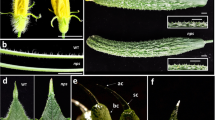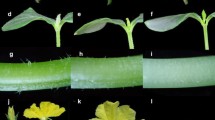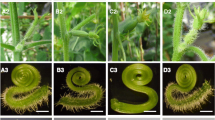Abstract
Key message
Map-based cloning identified CmGL that encodes a HD-ZIP type IV transcription factor that controls multicellular trichome initiation in melon.
Abstract
Trichomes are small hairs covering the aerial parts of plants that originate from the epidermal cells, which can protect plants against the damage by insects and pathogens. The regulatory pathway of unicellular trichomes has been well studied in the model plant Arabidopsis. Little is known about the genetic control and regulation of trichome development in melon (Cucumis melo L.) which has multicellular trichomes. In this study, we identified a melon mutant, cmgl, which showed completely glabrous on all aerial organs. A bulked segregant analysis was conducted to identify polymorphic markers for linkage analysis in a population with 256 F2 plants, which allowed to locate the cmgl locus in melon chromosome VIII. Next-generation sequencing-aided marker discovery and fine mapping in a large population with 1536 F2 plants narrowed the candidate gene region to 12 kb that harbored only one candidate gene for cmgl, which encoded a class IV homeodomain-associated leucine zipper transcription factor. Four SNPs in the coding region of the CmGL gene were identified between the two parental lines; a single base substitution from C to A resulted in a premature termination codon and a truncated protein in the cmgl. The SNP was converted into a dCAPS marker, which showed co-segregation in the F2 population and 564 melon accessions. Result of this study will be helpful for better understanding of genetic control of trichome development in melon and marker-assisted selection in developing new cultivars.





Similar content being viewed by others
References
Argyris JM, Ruiz-Herrera A, Madriz-Masis P, Sanseverino W, Morata J, Pujol M, Ramos-Onsins SE, Garcia-Mas J (2015) Use of targeted SNP selection for an improved anchoring of the melon (Cucumis melo L.) scaffold genome assembly. BMC Genom 16:4
Ariel FD, Manavella PA, Dezar CA, Chan RL (2007) The true story of the HD-Zip family. Trends Plant Sci 12:419–426
Boualem A, Fergany M, Fernandez R, Troadec C, Martin A, Morin H, Sari MA, Collin F, Flowers JM, Pitrat M, Purugganan MD, Dogimont C, Bendahmane A (2008) A conserved mutation in an ethylene biosynthesis enzyme leads to andromonoecy in melons. Science 321:836–838
Boualem A, Troadec C, Camps C, Lemhemdi A, Morin H, Sari MA, Fraenkel-Zagouri R, Kovalski I, Dogimont C, Perl-Treves R, Bendahmane A (2015) A cucurbit androecy gene reveals how unisexual flowers develop and dioecy emerges. Science 350:688–691
Chen K, Wallis JW, McLellan MD, Larson DE, Kalicki JM, Pohl CS, McGrath SD, Wendl MC, Zhang Q, Locke DP, Shi X, Fulton RS, Ley TJ, Wilson RK, Ding L, Mardis ER (2009) BreakDancer: an algorithm for high-resolution mapping of genomic structural variation. Nat Methods 6:677–681
Chen CH, Liu ML, Jiang L, Liu XF, Zhao JY, Yan SS, Yang S, Ren HZ, Liu RY, Zhang XL (2014) Transcriptome profiling reveals roles of meristem regulators and polarity genes during fruit trichome development in cucumber (Cucumis sativus L.). J Exp Bot 65:4943–4958
Chenna R, Sugawara H, Koike T, Lopez R, Gibson TJ, Higgins DG, Thompson JD (2003) Multiple sequence alignment with the Clustal series of programs. Nucleic Acids Res 31:3497–3500
Cohen S, Itkin M, Yeselson Y, Tzuri G, Portnoy V, Harel-Baja R (2014) The PH gene determines fruit acidity and contributes to the evolution of sweet melons. Nat Commun 5:4026
Cui JY, Miao H, Ding LH, Wehner TC, Liu PN, Wang Y, Zhang SP, Gu XF (2016) A new glabrous gene (csgl3) identified in trichome development in cucumber (Cucumis sativus L.). PLoS One 11(2):e0148422
DeLuca DS, Levin JZ, Sivachenko A, Fennell T, Nazaire MD, Williams C, Reich M, Winckler W, Getz G (2012) RNA-SeQC: RNA-seq metrics for quality control and process optimization. Bioinformatics 28:1530–1532
Feder A, Burger J, Gao S, Lewinsohn E, Katzir N, Schaffer AA, Meir A, Davidovich-Rikanati R, Portnoy V, Gal-On A, Fei Z, Kashi Y, Tadmor Y (2015) A Kelch domain-containing F-box coding gene negatively regulates flavonoid accumulation in muskmelon. Plant Physiol 169:1714–1726
Foster RE (1963) Glabrous, a new seeding marker in muskmelon. J Hered 54:113–114
Fu R, Liu W, Li Q, Li J, Wang L, Ren Z (2013) Comprehensive analysis of the homeodomain-leucine zipper IV transcription factor family in Cucumis sativus. Genome 56:395–405
Garcia-Mas J, BenjakA Sanseverino W, Bourgeois M et al (2012) The genome of melon (Cucumis melo L.). Proc Natl Acad Sci USA 109:11872–11877
Gregory P, Tingey WM, Ave DA, Bouthyette PY (1986) Potato glandular trichomes: a physicochemical defense mechanism against insects. ACS Symp Ser Am Chem Soc 296:160–167
Hulskamp M (2004) Plant trichomes: a model for cell differentiation. Nat Rev Mol Cell Biol 5:471–480
Hulskamp M, Schnittger A, Folkers U (1999) Pattern formation and cell differentiation: trichomes in Arabidopsis as a genetic model system. Int Rev Cytol 186:147–178
Ishida T, Kurata T, Okada K, Wada T (2008) A genetic regulatory network in the development of trichomes and root hairs. Annu Rev Plant Biol 59:365–386
Kennedy GG, Sorenson CF (1985) Role of glandular trichomes in the resistance of Lycopersicon hirsutum f. glabratum to Colorado potato beetle (Coleoptera: Chrysomelidae). J Econ Entomol 78:547–551
Kirik V, Simon M, Wester K, Schiefelbein J, Hulskamp M (2004) ENHANCER of TRY and CPC 2 (ETC2) reveals redundancy in the region-specific control of trichome development of Arabidopsis. Plant Mol Biol 55:389–398
Kirik V, Lee MM, Wester K, Herrmann U, Zheng Z, Oppenheimer D, Schiefelbein J, Hulskamp M (2005) Functional diversification of MYB23 and GL1 genes in trichome morphogenesis and initiation. Development 132:1477–1485
Kirkbride JH (1993) Biosystematic monograph of the genus Cucumis (Cucurbitaceae): botanical identification of cucumbers and melons. Parkway Publishers, Boone
Li H, Durbin R (2009) Fast and accurate short read alignment with Burrows–Wheeler transform. Bioinformatics 25:1754–1760
Li H, Handsaker B, Wysoker A, Fennell T, Ruan J, Homer N, Marth G, Abecasis G, Durbin R, Genome Project Data Processing Subgroup (2009) The Sequence Alignment/Map format and SAM tools. Bioinformatics 25:2078–2079
Li D, Cuevas H, Yang L, Li Y, Garcia-Mas J, Zalapa J, Staub J, Luan F, Reddy U, He X, Gong Z, Weng Y (2011) Syntenic relationships between cucumber (Cucumis sativus L.) and melon (C. melo L.) chromosomes as revealed by comparative genetic mapping. BMC Genom 12:396
Martin A, Troadec C, Boualem A, Rajab M, Fernandez R, Morin H, Pitrat M, Dogimont C, Bendahmane A (2009) A transposon-induced epigenetic change leads to sex determination in melon. Nature 461:1135–1237
Mayda E, Tornero P, Conejero V, Vera P (1999) A tomato homeobox gene (HD-zip) is involved in limiting the spread of programmed cell death. Plant J 20:591–600
Mukherjee K, Brocchieri L, Burglin TR (2009) A comprehensive classification and evolutionary analysis of plant homeobox genes. Mol Biol Evol 26:2775–2794
Murray MG, Thompson WF (1980) Rapid isolation of high molecular weight plant DNA. Nucleic Acids Res 8:4321–4325
Nakamura M, Katsumata H, Abe M, Yabe N, Komeda Y, Yamamoto KT, Takahashi T (2006) Characterization of the class IV homeodomain-leucine zipper gene family in Arabidopsis. Plant Physiol 141:1363–1375
Neff MM, Neff JD, Chory J, Pepper AE (1998) dCAPS, a simple technique for the genetic analysis of single nucleotide polymorphisms: experimental applications in Arabidopsis thaliana genetics. Plant J 14:387–392
Palomares-Rius FJ, Yuste-Lisbona FJ, Viruel MA, Lopez-Sese AI, Gomez-Guillamon ML (2016) Inheritance and QTL mapping of glandular trichomes type I density in Cucumis melo L. Mol Breed 36:132
Pan YP, Bo KL, Cheng ZH, Weng YQ (2015) The loss-of-function GLABROUS 3 mutation in cucumber is due to LTR-retrotransposon insertion in a class IV HD-ZIP transcription factor gene CsGL3 that is epistatic over CsGL1. BMC Plant Biol 15:302
Payne T, Clement J, Arnold D, Lloyd A (1999) Heterologous myb genes distinct from GL1 enhance trichome production when overexpressed in Nicotiana tabacum. Development 126:671–682
Payne CT, Zhang F, Lloyd AM (2000) GL3 encodes a bHLH protein that regulates trichome development in Arabidopsis through interaction with GL1 and TTG1. Genetics 156:1349–1362
Pesch M, Hulskamp M (2009) One, two, three…models for trichome patterning in Arabidopsis? Curr Opin Plant Biol 12:587–592
Sarria E, Palomares-Rius FJ, Lopez-Sese AI, Heredia A, Gomez-Guillamon ML (2010) Role of leaf glandular trichomes of melon plants in deterrence of Aphis gossypii Glover. Plant Biol 12:503–511
Schellmann S, Hulskamp M (2005) Epidermal differentiation: trichomes in Arabidopsis as a model system. Int J Dev Biol 49:579–584
Schiefelbein J (2003) Cell-fate specification in the epidermis: a common patterning mechanism in the root and shoot. Curr Opin Plant Biol 6:74–78
Schrick K, Nguyen D, Karlowski WM, Mayer KF (2004) START lipid/sterol-binding domains are amplified in plants and are predominantly associated with homeodomain transcription factors. Genome Biol 5:R41
Sebastian P, Schaefer H, Telford IRH, Renner SS (2010) Cucumber (Cucumis sativus) and melon (C. melo) have numerous wild relatives in Asia and Australia, and the sister species of melon is from Australia. Proc Natl Acad Sci USA 107:14269–14273
Serna L, Martin C (2006) Trichomes: different regulatory networks lead to convergent structures. Trends Plant Sci 11:274–280
Shan CM, Shangguan XX, Zhao B, Zhang XF, Chao LM, Yang CQ (2014) Control of cotton fibre elongation by a homeodomain transcription factor GhHOX3. Nat Commun 5:5519
Sherman A, Eshed R, Harel-Beja R, Tzuri G, Portnoy V, Cohen S, Rubinstein M, Schaffer AA, Burger J, Katzir N, Ophir R (2013) Combining bulk segregation analysis and microarrays for mapping of the pH trait in melon. Theor Appl Genet 126:349–358
Tamura K, Peterson D, Peterson N, Stecher G, Nei M, Kumar S (2011) MEGA5: molecular evolutionary genetics analysis using maximum likelihood, evolutionary distance, and maximum parsimony methods. Mol Biol Evol 28:2731–2739
Vernoud V, Laigle G, Rozier F, MeeleyRB Perez P, Rogowsky PM (2009) The HD-ZIP IV transcription factor OCL4 is necessary for trichome patterning and anther development in maize. Plant J 59:883–894
Walker AR, Davison PA, Bolognesi-Winfield AC, James CM, Srinivasan N, Blundell TL, EschJJ Marks MD, Gray JC (1999) The TRANSPARENT TESTA GLABRA1 locus, which regulates trichome differentiation and anthocyanin biosynthesis in Arabidopsis, encodes a WD40 repeat protein. Plant Cell 11:1337–1350
Wang YL, Nie JT, Chen HM, Guo CL, Pan J, He HL, Pan JS, Cai R (2016) Identification and mapping of Tril, a homeodomain-leucine zipper gene involved in multicellular trichome initiation in Cucumis sativus. Theor Appl Genet 129:305–316
Werker E (2000) Trichome diversity and development. Adv Bot Res 31:1–35
Wester K, Digiuni S, Geier F, Timmer J, Fleck C, Hulskamp M (2009) Functional diversity of R3 single-repeat genes in trichome development. Development 136:1487–1496
Yang CX, Li HX, Zhang JH, Luo ZD, Gong PJ, Zhang CJ, Li JH, Wang TT, Zhang YY, Lu YE, Ye ZB (2011) A regulatory gene induces trichome formation and embryo lethality in tomato. Proc Natl Acad Sci USA 108:11836–11841
Yang L, Koo DH, Li D, Zhang T, Jiang J, Luan F, Renner SS, Henaff E, Sanseverino W, Garcia-Mas J, Casacuberta J, Senalik DA, Simon PW, Chen J, Weng Y (2014) Next-generation sequencing, FISH mapping and synteny-based modeling reveal mechanisms of decreasing dysploidy in Cucumis. Plant J 77:16–30
Zhang BC, Tolstikov V, Turnbull C, Hicks LM, Fiehn O (2010) Divergent metabolome and proteome suggest functional independence of dual phloem transport systems in cucurbits. Proc Natl Acad Sci USA 107:13532–13537
Zhao JL, Pan JS, Guan Y, Zhang WW, Bie BB, Wang YL, He HL, Lian HL, Cai R (2015) Micro-trichome as a class I homeodomain-leucine zipper gene regulates multicellular trichome development in Cucumis sativus. J Integr Plant Biol 57:925–935
Zhu H, Guo L, Song P, Luan F, Hu J, Sun X, Yang L (2016) Development of genome-wide SSR markers in melon with their cross-species transferability analysis and utilization in genetic diversity study. Mol Breed 36:153
Acknowledgements
This work was supported by grants from the National Natural Science Foundation of China (No. 31601776), the Scientific Innovation Fund of Henan Agricultural University (KJCX2016A15), and the International Scientific and Technological Cooperation Project of Henan Province.
Author information
Authors and Affiliations
Corresponding author
Ethics declarations
Ethical standard
The experiments comply with the current laws of the country in which we were performed.
Conflict of interest
The authors declare that they have no conflict of interest.
Accession codes
The genomic resequence datasets of two melon materials M465 and NSL73046 have been deposited into the NCBI sequence read archive (SRA) SRP119828 under accessions SRS2585930 and SRS2585931.
Additional information
Communicated by Herman J. van Eck.
Electronic supplementary material
Below is the link to the electronic supplementary material.
122_2017_3019_MOESM1_ESM.pdf
Figure S1 Phylogenetic tree of CmGL and HD-ZIP IV proteins in other species. The HD-ZIP IV proteins used for phylogenetic analysis including 16 from Arabidopsis (ATML-1, PDF2, ANL2, GL2, HDG1 to HDG12), 1 from tomato (Wo), 4 from maize (ZmOCL1–ZmOCL4), 2 from rice (OsRoc1, OsRoc5), and 6 from cotton (GhHD-1A, GhHD-1D, GaHOX1, GaHOX2, GaHOX3-A and GaHOX3-D) (PDF 15 kb)
122_2017_3019_MOESM3_ESM.xlsx
Table S1 The list of melon germplasm used for analyzing allelic diversity of CmGL gene. Table S2 The list of primers used for mapping and qRT-PCR analysis (XLSX 33 kb)
Rights and permissions
About this article
Cite this article
Zhu, H., Sun, X., Zhang, Q. et al. GLABROUS (CmGL) encodes a HD-ZIP IV transcription factor playing roles in multicellular trichome initiation in melon. Theor Appl Genet 131, 569–579 (2018). https://doi.org/10.1007/s00122-017-3019-9
Received:
Accepted:
Published:
Issue Date:
DOI: https://doi.org/10.1007/s00122-017-3019-9




